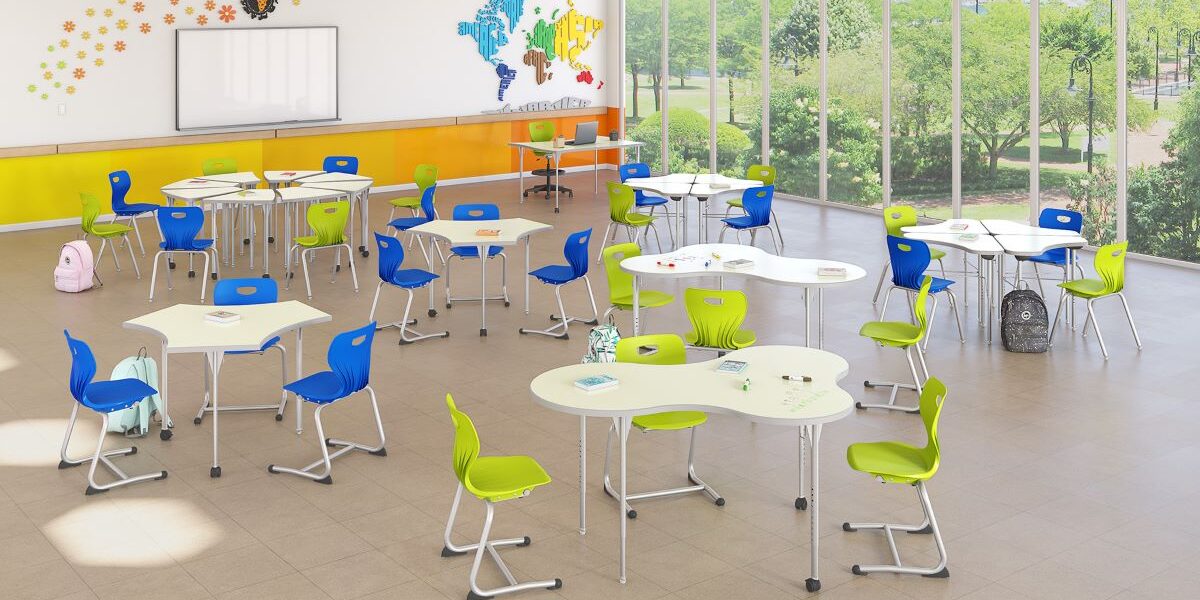With the start of a new school year, it can be overwhelming for teachers as they prepare to return to the classroom.
Between lesson planning, memorizing student names, class organization, and supplies checklist, the last thing on their mind might be how the classroom is arranged — as long as they have desks and chairs, right?
Yet, a classroom environment with a thoughtful layout can significantly affect a student’s attitude toward the subject. When learning spaces are intentionally designed, they can transform student participation and invite collaboration with classmates.
I can remember times I’ve walked into a class with a new layout from the day before and instantly felt curious excitement. I’d see the desks arranged with a new set up and would think to myself, I wonder what we’re going to do today. This positive surprise always helped reinvigorate my desire to learn in the class.
Switching up the classroom layout will not only improve your students’ experience, but also yours as an educator. Students who are excited to be in your classroom can make your role easier and more fulfilling.
In this article, we’ll explore a few furniture arrangements that can help promote student interaction and collaboration in your classroom.
Benefits of Collaborative Learning Spaces
Develop your students’ interpersonal skills
Collaborative learning environments allow students to engage with their peers in a group setting and improve their communication and teamwork skills.
Stimulates higher-level thinking
Through interactions with classmates, students are exposed to diverse perspectives and ideas, leading to deeper and more critical thinking as they learn from one another.
Boost in self-esteem
In a collaborative environment, each student’s contribution becomes integral to the overall success of the group, which helps students feel like they matter. This boosts their self-esteem and sense of value, while also improving classmate camaraderie.
Deepens interest in the topic
Working alongside classmates can contribute to a positive outlook on the subject matter. By creating an interactive atmosphere, it encourages students to practice active listening and understanding. The exchange of ideas and explanations within a collaborative learning setup also aids in reinforcing concepts, leading to better retention of information among students.
Classroom Arrangements to Increase Student Collaboration
Cluster seating
Arrange desks or tables in small clusters of desks or tables that seat around 4-6 to encourage group discussions and teamwork. These collaborative pods encourage students to work together closely, making it easier to share ideas, discuss concepts, and complete group projects.
U-shaped setup
This layout places desks or tables in a semi-circle, with an open end facing the instructor’s area. This configuration promotes face-to-face interactions, making it easier for students to engage in presentations and group activities. This setup is particularly effective for class discussions, as it allows students to see and interact with both their peers and the teacher.
Fishbowl arrangement
Arrange chairs in an inner circle and outer circle configuration. This setup is particularly effective for discussions, debates, or role-playing activities. Students in the inner circle actively participate, while those in the outer circle watch and provide feedback, fostering a dynamic exchange of ideas.
Lounge-style seating areas
When students are working on creative group projects, consider informal lounge areas with comfortable seating options like bean bags, couches, and floor cushions. These relaxed settings can foster casual conversations and brainstorming sessions, promoting a more comfortable and open environment for student interaction. This layout can also work for independent brainstorming and personal reading time.
Add Movement
It’s no secret that students like to move around. Moving your body can help make class more exciting, and many believe that movement increases students’ ability to process and retain new material. In fact, movement-based instruction is a teaching method centered around this very concept.
Here are a few ways you can add just a little movement to your classroom configurations:
Standing stations
Introduce standing collaborative stations equipped with whiteboards or interactive displays. Students can gather around these stations to brainstorm ideas, solve problems, and work on projects together. Standing desks can also help improve focus and engagement during discussions.
Movable furniture
If your school board is in the market for new classroom furniture, advocate for movable furniture, such as lightweight tables and chairs with wheels. This adaptability allows for quick reconfiguration of the classroom to suit different activities, from group discussions to individual work. Rotating chairs also allow students to easily turn and collaborate with peers on either side. This setup accommodates a variety of group sizes and encourages spontaneous interactions without the need for major furniture rearrangements.
‘Speed-dating’ layout
Push your tables together to create a long row and face students on opposite sides of each other. When doing an activity, have one row of students stay put, and the other side cycle through every minute or so. This is a perfect layout for “get-to-know-you” activities, discussion questions, and debates. Just moving seats and getting to socialize with new peers can help keep students stimulated and engaged in the lesson.
The layout of classroom furniture can play a pivotal role in promoting student interaction. By thoughtfully designing these spaces, educators can create environments that encourage active participation, teamwork, and creative thinking.
Whether it’s through creative clusters or versatile mobile furniture, the goal stays the same: facilitate meaningful interactions that will enhance your students’ overall learning experience.
Andrea Wolfe is with USACapitol, an educational furniture manufacturer on a mission to inspire enriched learning environments. Established in 1986 as a family-owned business based in Central Texas, USACapitol’s legacy is built upon innovation, excellence, and a deep-seated passion for enhancing learning spaces and propelling our country forward, www.usacapitol.com.








